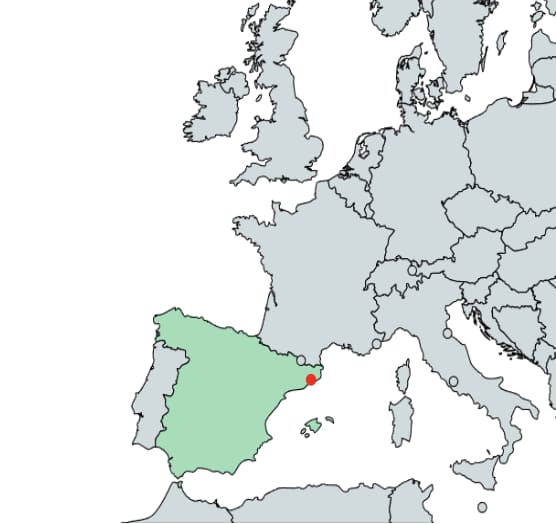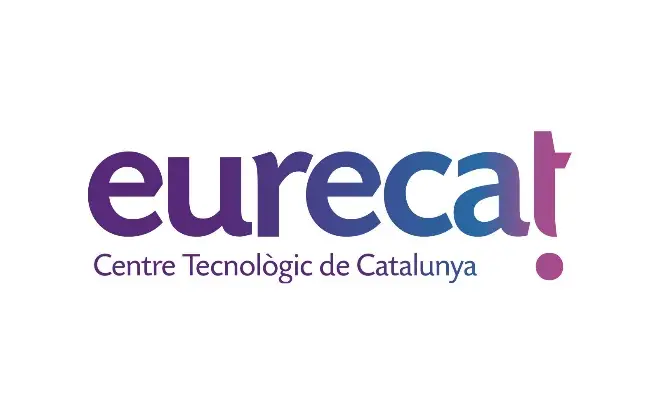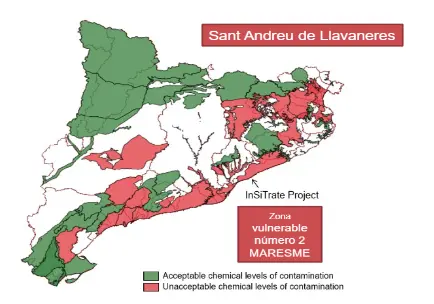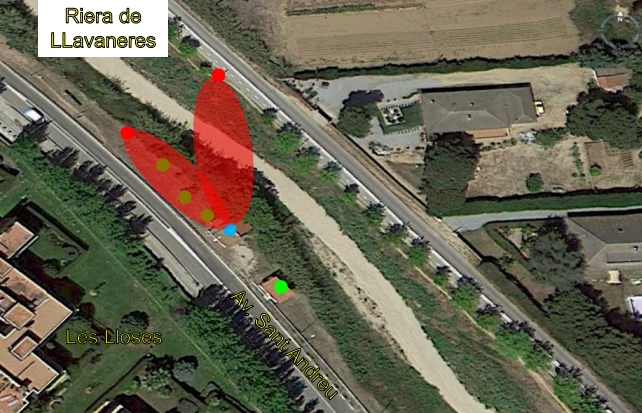InSiTrate
In situ groundwater nitrate removal technology
Insitrate
Download the practice
People in charge of the innovative practice :
Irene Jubany Güell – irene.jubany@eurecat.org
InSiTrate is a technology developed by Eurecat (before CTM Technological Center) in the context of the Life+ program, in collaboration with the companies Amphos21 and Catalana de Perforacions. Catalonia has a large part of the underground water bodies contaminated by nitrates. In this sense, this consortium has developed an in situ nitrate removal technology based on bioremediation.

The results of the pilot plant are promising, reaching percentages of elimination of nitrate concentration above 80%. The on-site treatment plant is automatic and does not generate waste that needs to be treated or disposed of later.
The InSiTrate project is not a management action but is a technological application that requires certain hydrogeological conditions of the aquifer for its correct performance. However, its local approach, low cost and high efficiency make it an interesting reference in the treatment of groundwater
Responsible entity
Eurecat, Technological Centre of Catalonia promotes the competitiveness of companies and the well-being of society through applied research and innovation.

https://eurecat.org/es/
Eurecat es the main technology center in Catalonia and the second private organization in Spain in raising funds of H2020. It is an entity specialized in offering services Applied R&D, technological, highly specialized training, technological consulting and professional events for companies from all sectors. Ha participado in more than 200 large national and international R&D&I consortium projects of high strategic value and has 88 patents and 7 spin-offs.
Eurecat develops and optimizes technologies and processes to improve water, soil and air management, as well as associated resources. They carry out research, development and innovation projects with companies from all sectors to improve economic, environmental and social sustainability.
They use advanced modelling and experimentation tools at different scales (laboratory, pilot plant and real scale) to develop and validate new technologies and their applications. It works with a wide range of pollutant treatment technologies to limit their presence in the natural environment, as well as to recover water resources and support the transition to a circular economy.
The experience of the Water, Air and Soil Unit, combined with the capabilities of the different technological units of Eurecat, allows to provide solutions to complex and specific problems in a wide range of sectors: water treatment, chemical, agri-food, pharmaceutical or basic industries and capital goods, among others.
In the water sector, the main objectives are:
Development and optimization of: Water management and associated resources, processes for the elimination of trace and/or recalcitrant compounds, effluent treatment and in-situ and ex-situ treatment technologies
Advanced separation processes, biological treatment, advanced oxidation, electrochemical and disinfection for liquid treatment.
Identification and evaluation of opportunities to improve efficiency and implement a circular economy.
Identification and development of processes for cascade recirculation and reuse in industrial processes.
Recovery of water resources and liquid effluents (nutrients, energy, raw materials).
Tools for monitoring, prediction and quality assurance in distribution networks.
Studies, modelling and simulation of the behaviour and mobility of pollutants in soils and groundwater.
Bioremediation processes with nanoparticles, monitored natural attenuation, reactive permeable barriers, chemical oxidation, stripping, etc.
Recovery of waste / by-products for the improvement of the physicochemical properties of the soil.
Detailed explanation
The most commonly used conventional technologies for nitrate removal first require the extraction of water for further treatment. Ex situ technologies are expensive and can generate unwanted by-products (waste). The Life+ InSiTrate project shows the feasibility of in situ technology based on the process of induced bioremediation.
The objectives of Life+ InSiTrate were:
- Demonstrate on a pilot scale the feasibility of in situ bioremediation technology of nitrate-contaminated groundwater for the production of drinking water.
- The development of an innovative design and prediction tool based on a mathematical model that describes the process of in situ bioremediation in any aquifer and helps the design of optimal remediation strategies for other sites.
- The study of the feasibility of the technology in situ from the technical, environmental and economic point of view, and the comparison of this technology with other existing ones using the same indicators.

Figura 2: Esquema planta piloto de Sant Andreu de Llavaneres. Recuperado de Layman’s Report
4.Promote social acceptance of this technology and encourage the participation of stakeholders and working groups in the development of the technology.
5.The study of the extrapolation of the technology in other specific European sites to demonstrate its potential application.
The process of induced bioremediation consists of the acceleration of the natural process of denitrification by the microorganisms present in the affected aquifer. Nitrates are transformed into nitrogen gas by a sequence of microbial reduction reactions. In this case, theinjection of organic matter (acetic acid) into the aquifer induces bioremediation.
To carry out the project and build the pilot plant, a hydrogeological and chemical characterization of the aquifer (InSiTrate, n.d.) was carried out.
The IST-InSiTrate tool is a useful instrument for decision making, simulates the remediation process under the different injection strategies and hydrogeological characteristics in order to identify the optimal configuration of the denitrification plants (InSiTrate, n.d.), and facilitates the design and remediation strategy of the aquifer, defining the configuration and operating parameters of the plant. (InSiTrate, 2017).
Description ofthe pilot press
The plant has two injection wells (I1 and I2; Figure 2), an extraction well at a distance of 30 m from I1 and I2, and three piezometers (P1, P2 and P3).
The results of the project demonstrate the reduction of nitrate concentration between 80-100% in the monitoring wells and about 30% in the extraction wells.
The main problem was bioclogging that was solved by injecting the organic matter by pulses and performing periodic cleanings.
The social projection to implement innovative technologies was essential. Open approaches and close collaboration of the research groups and social interest groups involved were required, generating a participatory and integrated approach with the social context. The communication and dissemination plan has been structured in a series of tasks aimed at informing citizens of the objectives and developmentof the project in addition to facilitating the results obtained.
The technology at the commercial level requires that the system bescaled, for this the installation of 5 injection wells is required to create the reaction zone where the denitrification will be accelerated (I. Jubany et al 2019).
Institutional setting
Eurecat technology development center InSiTrate is framed in the LIFE+ program of the European Union, the framework of the joint participation with the companies Amphos21 and Catalana de Perforacions. The Catalan Water Agency (ACA) and the City Council of Llavaneres also collaborate in the project.
Geographical setting
La contaminación por nitratos procede de actividades antropogénicas como la aplicación de fertilizantes asociada a una mala praxis de las excreciones ganaderas, siendo una de las causas de incumplimiento de la Directiva marco del agua en cuánto a la calidad de los recursos hidrogeológicos. En Cataluña, concretamente, existe una afectación elevada de contaminación de las aguas subterráneas asociada a este compuesto, alcanzando el 33% de la superficie (ACA, s.f) (Figura 1).
La planta piloto para el tratamiento de la contaminación por nitrato en el acuífero aluvial de la riera de Llavaneres se construyó a 10 m de la riera de Sant Andreu de Llavaneres (comarca del Maresme). He alluvial aquifer is formed by sediments of coarse sands and silts of the Quaternary that cover a granite formation (InSiTrate, 2017).


Historical overview
The idea of restoring soils contaminated with oil or its derivatives using microorganisms was put forward in 1930 by Tausz and Donatli (K. Cota-Ruiz, 2019). In this context of oil is where the first ideas that put the pillars of bioremediation appear, bioremediation is a biotechnology of several decades old, however, during the last years different bioremediation strategies have been developed and improved (C. Della Rocca et al. 2007).
In situ technologies are based on the directtreatment of groundwater (by chemical or biological processes) in the contaminated aquifer before it is pumped, unlike ex situ techniques that focus on treating contaminated water once extracted to the surface (ACA, 2017). Nitrate pollution in Catalonia in relation to in situ technologies is still at a very early stage compared to the currently more developed ex situ technologies.
One of the outstanding methodologies is the one used in the InSiTrate project: heterotrophic denitrification in situ.
Evidence of benefits from implementation
The bioremediation technology used in the Insitrate project has demonstrated the feasibility of nitrate removal in alluvial aquifers with reduction levels above 80% of the pollutant.
The plant works automatically and does not require personnel. It does not generate waste avoiding problems and management costs.
The application of this technology uses the aquifer as a reactor and at the same time compared to other ex situ biological systems consumes fewer reagents. In this sense, these characteristics make it a competitive technology, economically compared to ex-situ ones.
Replication potential in SUDOE region
The InSiTrate project provides an innovative technological application in order to show its efficiency and viability, linking it to the acceptance of social agents through a process of public participation.
This technology shows how an efficient point action in a site with certain characteristics can be developed in an unconfined porous aquifer, with an area that allows the installation of wells in a radius of 30 m around the supply well.
Obviously, its replicability will depend on geographical, hydrogeological and economic factors. Its level of efficiency allows it to be compared with other existing technologies and to consider its feasibility.
Future outlook
Nitrate concentrations in groundwater is a growing problem, linked to land uses and anthropic activities. In this sense, the development of high-efficiency remediation technologies in the removal or conversion of nitrates, economical and easy to use, is expected to be key to solving the quality problems associated with nitrates. It should be noted the importance of in-situ techniques avoiding large works outside the aquifer and the extraction of water to be treated outside it.
Key points of the innovative method
- Solución tecnológica de alta eficiencia para la remoción de nitratos
- Sistema automatizado controlado remotamente facilitando la captación en zonas alejadas.
- Fomenta la implicación de distintos sectores sociales.
Acknowledgements
Innovative practice was suggested by Irene Jubany Research coordinator of the Sustainability Area in Eurecat.
References
- Zonas vulnerables por nitratos de origen agrario. (s/f). Agencia Catalana del Agua. Recuperado el 25 de mayo de 2022, de https://aca.gencat.cat/es/laigua/el-medi-hidric-a-catalunya/zones-protegides-i-habitats/zones-vulnerables-per-nitrats-dorigen-agrari/
- Insitrate (2017) Layman’s Report recuperado de: http://insitrate.ctm.com.es/es/descargas/insitrate_layman_27_06.pdf/view
- Insitrate. (s/f). El proyecto. http://Insitrate.Ctm.com.Es/Es/the-Project. Recuperado el 25 de mayo de 2022, de http://insitrate.ctm.com.es/es/the-project
- Margalef-Marti, R., Carrey, R., Viladés, M., Jubany, I., Vilanova, E., Grau, R., Soler, A., & Otero, N. (2019). Use of nitrogen and oxygen isotopes of dissolved nitrate to trace field-scale induced denitrification efficiency throughout an in-situ groundwater remediation strategy. Science of the Total Environment, 686, 709–718.
- Cota-Ruiz, K., Nuñez-Gastelúm, J. A., Delgado-Rios, M., & Martinez-Martinez, A. (2019). BIORREMEDIACIÓN: ACTUALIDAD DE CONCEPTOS Y APLICACIONES BIOREMEDIATION: CURRENT CONCEPTS AND APPLICATIONS. http://biotecnia.unison.mx
- Della Rocca, C., Belgiorno, V., & Meriç, S. (2007). Overview of in-situ applicable nitrate removal processes. Desalination, 204(1-3 SPEC. ISS.), 46–62.
- INFORME FINAL DE PROJECTE Desenvolupament d’un prototip de sistema d’ajuda a la decisió i d’una base de dades sobre el territori, per tal de facilitar la presa de decisions sobre les properes inversions per a la instal·lació de tecnologies per al tractament de Nitrats a Catalunya. (2017). ACA
aquifer
news
Discover more on the Aquifer project news and on aquifer management
aquifer news
Description and objectives of the project
The scientific community recommends a substantial improvement in the knowledge of aquifers, the establishment of reliable monitoring networks and a greater involvement of the administration and users to achieve a sustainable management of aquifers. The main objective...
Information on the project
The Llobregat Delta Water Users' Community has designed recharge basins in Molins de Rei to recharge the Baix Llobregat aquifer. View of one of the reloading basins during the test phase The Llobregat Delta Water Users' Community is one of the nine partners in the...
Success stories in groundwater management
Compilation of groundwater management success stories completed. Throughout April, the 30 cases of innovative practices in groundwater management have already been selected by the clusters participating in the project: PPA, CWP and AV. The task started with the...
PROPOSE AN
INNOVATIVE PRACTICE
You are in charge of an innovative practice regarding aquifer management and you want to referenced it on the Aquifer platform ?
Fulfill the form and propose it to the Aquifer partners.
THE EBOOK
Aquifer offers a range of innovative water management practices. You can download all our fact sheets here.
e-book of innovative practices
DOCUMENTATION
To go further on information related to the management of aquifers